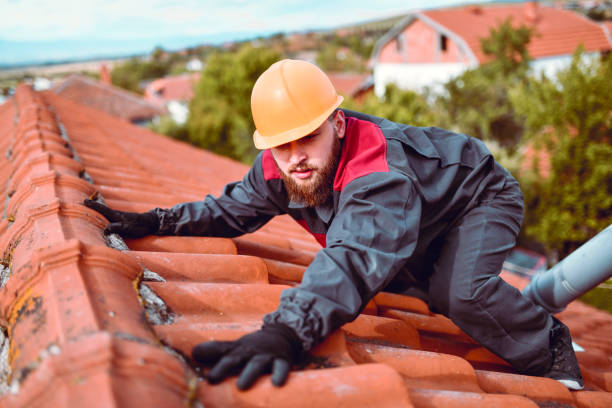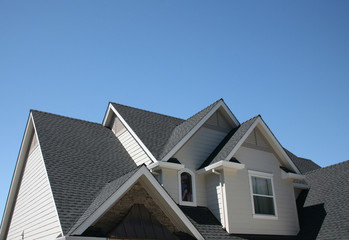A roof ridge vent is a simple way to keep your home cooler in summer and fresher all year. It’s installed along the top of your roof to let hot, stuffy air out and bring in fresh air through the soffit vents. This natural airflow helps your home stay comfortable while lowering energy bills.
Not only does it make your home feel better, but a roof ridge vent also protects your roof. It helps stop moisture, mold, and damage that can lead to expensive repairs. With this small upgrade, your roof lasts longer, your home stays healthy, and you save money in the long run.
Table of Contents
Ridge Vent Installation
Is your house too hot in summer? Do you see ice on your roof in winter? The fix might be simple. It’s called a roof ridge vent.
Think of your house like a person. It needs to breathe out hot, wet air to stay healthy. A ridge vent is like a tiny hat with holes that sits on the very top of your roof. It lets the bad air out.
This keeps your house more comfortable and can even save you money.

Benefits of a Ridge Vent
| Problem | What Happens | How a Ridge Vent Helps |
|---|---|---|
| Too Much Heat | Attic heats up, making house warmer. | Lets hot air escape. Cools home. |
| Wet Air & Mold | Moisture turns to water in attic. | Removes damp air. Prevents mold. |
| Ice Dams | Melted snow refreezes, causing ice. | Keeps attic cool. Stops ice dams. |
| Wear and Tear | Heat and moisture damage roof over time. | Reduces damage. Extends roof life. |
Roof Vent Types
Is your house feeling stuffy? Are your energy bills too high? The problem might be right over your head. Your roof needs to breathe, and without the right roof ridge vent or other vent, it can’t.
Here’s a look at the most popular roof vents and what makes them special.
| Vent Type | Best For | How It Works | Looks Like |
| Ridge Vent | Most homes; the modern standard. | A long vent that runs along the entire peak of the roof. Lets hot air seep out evenly. | Hides under the roof cap shingles. You barely see it. |
| Static Vents | Homes that can’t have a ridge vent. | Also called “box vents” or “turtle vents.” They are placed over a hole in the roof. | Small boxes on your roof. You need several for them to work well. |
| Wind Turbines | Windy areas; no electricity needed. | The wind spins a turbine, which pulls hot air out of the attic. | Metal domes that spin. You can see and sometimes hear them. |
| Power Vents | Hot climates; attics that need extra help. | An electric fan that actively sucks hot air out of the attic. | A low-profile box with a fan inside. Needs electricity. |
| Soffit Vents | EVERY home (This is an intake vent!). | Strips or circles under the roof’s edge that let cool air in. | Hidden under the eaves. You have to look up to see them. |
Does a Ridge Vent Save Money?
Yes! A roof ridge vent is an easy way to save money and protect your home. It lets hot, stuffy air escape from your attic and brings in fresh air, keeping your home cooler in summer and preventing moisture in winter. This means your AC and heater don’t have to work as hard, so your energy bills go down.
It also helps your roof last longer. Without good ventilation, heat and moisture can damage shingles, cause wood to rot, and even lead to mold. A roof ridge vent stops these problems, saving you from expensive repairs. It’s a small upgrade that keeps your home comfortable, safe, and budget-friendly.
Structure of Roof Ridge Vent
A roof ridge vent is a long, slim vent that runs along the very top peak of your roof. It’s hidden under special shingles that blend right in, giving your roof a clean, finished look.
Made from tough plastic or aluminum, it has clever inner channels and filters. These let hot, sticky air flow out of your attic while keeping rain, snow, and pests from getting in. It’s a simple, out-of-sight way to protect your home!
Common Roof Ridge Vent Installation Mistakes
1. Cutting the Opening Too Narrow
- Problem: The slot cut along the roof peak is not wide enough.
- Result: Hot air can’t escape properly. The vent doesn’t work well.
- Fix: Always check the vent manufacturer’s instructions for the correct width.
2. Not Having Enough Soffit Vents
- Problem: Soffit vents (under the eaves) are blocked, covered, or missing.
- Result: Cool air can’t get in, so the ridge vent has nothing to push out.
- Fix: Make sure soffit vents are clear and open before installing the ridge vent.
3. Using the Wrong Vent for Your Roof
- Problem: Picking a vent not meant for your roof’s slope or material.
- Result: Poor performance, leaks, or damage.
- Fix: Choose a vent designed for your specific roof type.
4. Not Sealing the Vent Properly
- Problem: Gaps are left between the vent and the roof.
- Result: Rain, snow, and pests can get into your attic.
- Fix: Use the correct nails and sealing strips as directed.
5. Installing the Vent on the Wrong Part of the Roof
- Problem: Putting the vent too low, not at the very top peak.
- Result: Airflow is weak and doesn’t work correctly.
- Fix: Always install the vent along the highest point (ridge) of the roof.
6. Covering the Vent Too Much with Shingles
- Problem: Cap shingles are layered too thickly over the vent.
- Result: Airflow is blocked.
- Fix: Install cap shingles so they cover the vent but don’t press down too hard.
Maintenance Tips for Homeowners
A little attention can make a big difference. Start by giving your ridge vent a quick visual check every few months. Look for loose or damaged shingles, and keep an eye out for moss or algae trying to make a home up there.
Make sure your vent isn’t blocked by leaves, nests, or winter ice—anything that clogs it can keep your attic from breathing the way it should. If trees are showering your roof with debris, a simple trim might be all you need.
And remember: sometimes it’s best to call in the pros! A quick inspection by a roofing expert can help your roof and your ridge vent last longer and work better.


Pros and cons
Thinking about getting a roof ridge vent for your home? It’s one of the most popular ways to ventilate an attic. But is it the right choice for YOU?
Like anything, it has its upsides and downsides. Let’s break down the pros and cons in plain, simple words so you can decide what’s best for your house.
The Pros (The Good Stuff!):
1. Looks Clean and Hidden
- It sits right on top of your roof and is covered with shingles.
- You can’t really see it—it keeps your roof looking nice!
2. Works Without Electricity
- It doesn’t need power—it uses wind and heat to move air out.
- Saves you money because it’s always working.
3. Helps Lower Energy Bills
- Lets hot air out in summer, so your AC doesn’t work as hard.
- Keeps your home cooler without costing you extra.
4. Protects Your Roof
- Stops moisture from building up and causing mold or rot.
- Helps your roof last longer.
The Cons (Things to Think About):
1. Needs Other Vents to Work
- It can’t work alone—it needs soffit vents (under the roof edges) to bring in cool air.
- If those are blocked, the ridge vent won’t work well.
2. Must Be Installed Perfectly
- If it’s not put in right, it could leak.
- Always hire a pro you trust!
3. Might Not Be Enough for Big Attics
- In very hot places or homes with big attics, you might need extra vents.
4. Bugs Might Try to Get In
- If the screen inside gets damaged, small insects or birds could sneak in.
- Good installation and regular checks can prevent this.
Is a Roof Ridge Vent Right For You?
Probably YES if:
- You want a vent that is out of sight.
- You are looking for a low-maintenance option.
- Your roof has good soffit vents for intake.
Think twice if:
- Your attic has existing ventilation problems.
- Your roof doesn’t have a clear, continuous ridge.
FAQ About Ridge Vents
How long does a roof ridge vent last?
A well-installed roof ridge vent can last as long as your roof typically 20+ years making it a long-term, low-maintenance solution.
Can I install a roof ridge vent myself?
While it’s possible, hiring a roofing expert is safer and ensures proper installation. A professional can make sure your vent works effectively and lasts for years.
How do I know if my roof needs a ridge vent?
If your attic feels hot and stuffy, your energy bills are high, or you notice moisture problems like mold, your roof may need better ventilation. A roof ridge vent can solve these issues quickly.
Does a roof ridge vent work in all weather conditions?
Yes! A roof ridge vent is designed to work year-round. It lets out hot air in summer, reduces moisture in winter, and keeps airflow balanced no matter the season.
Can a roof ridge vent make my home more energy-efficient?
Absolutely! With better airflow, your AC and heater don’t have to work as hard. This lowers energy use and helps you save on utility bills.
Conclusion
A roof ridge vent may seem like a small feature, but it makes a big difference for your home. By improving airflow, it keeps your attic cooler, lowers energy bills, and helps your roof last for years without costly repairs. It’s a simple upgrade that protects your home, saves you money, and keeps your family comfortable in every season.
If you’re looking for a smart, affordable way to care for your roof and improve your home’s efficiency, a roof ridge vent is the perfect choice. Take this step today, and enjoy a healthier, stronger, and more energy-efficient home for the future.
Contact US:
If you’re considering Roof ridge vent for your home or business, our expert team at United Developers MDVA is here to help. We provide professional guidance, quality installation, and reliable service to ensure your roof lasts for years.
READY TO PROTECT YOUR Home?
Discover top-rated construction, remodeling, and renovation services tailored to your needs.
Trusted by 50+ businesses across Maryland & Virginia.


